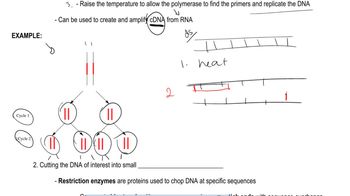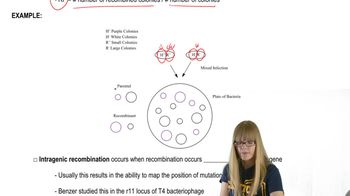Through the Human Genome Project (HGP), a relatively accurate human genome sequence was published from combined samples from multiple individuals. It serves as a reference for a haploid genome. How do results from personal genome projects (PGP) differ from those of the HGP?
Table of contents
- 1. Introduction to Genetics51m
- 2. Mendel's Laws of Inheritance3h 37m
- 3. Extensions to Mendelian Inheritance2h 41m
- 4. Genetic Mapping and Linkage2h 28m
- 5. Genetics of Bacteria and Viruses1h 21m
- 6. Chromosomal Variation1h 48m
- 7. DNA and Chromosome Structure56m
- 8. DNA Replication1h 10m
- 9. Mitosis and Meiosis1h 34m
- 10. Transcription1h 0m
- 11. Translation58m
- 12. Gene Regulation in Prokaryotes1h 19m
- 13. Gene Regulation in Eukaryotes44m
- 14. Genetic Control of Development44m
- 15. Genomes and Genomics1h 50m
- 16. Transposable Elements47m
- 17. Mutation, Repair, and Recombination1h 6m
- 18. Molecular Genetic Tools19m
- 19. Cancer Genetics29m
- 20. Quantitative Genetics1h 26m
- 21. Population Genetics50m
- 22. Evolutionary Genetics29m
15. Genomes and Genomics
Genomics and Human Medicine
Problem B.14e
Textbook Question
Select one of the hereditary conditions from either the RUSP core conditions list or the RUSP list of secondary conditions and do some online research to find the following information:
The duration of treatment
 Verified step by step guidance
Verified step by step guidance1
Identify a hereditary condition from the Recommended Uniform Screening Panel (RUSP) core or secondary conditions list. Examples include Phenylketonuria (PKU), Cystic Fibrosis, or Sickle Cell Disease.
Research reliable sources such as medical databases, genetics textbooks, or official health organization websites to gather information about the chosen condition.
Focus specifically on finding details about the duration of treatment for the condition. Treatment duration can vary depending on the condition's nature, severity, and patient response.
Summarize the treatment duration, noting whether it is lifelong, time-limited, or variable based on individual cases.
Optionally, note any factors that influence treatment duration, such as age at diagnosis, treatment adherence, or advancements in therapy.
 Verified video answer for a similar problem:
Verified video answer for a similar problem:This video solution was recommended by our tutors as helpful for the problem above
Video duration:
2mPlay a video:
Was this helpful?
Key Concepts
Here are the essential concepts you must grasp in order to answer the question correctly.
Newborn Screening and the RUSP
The Recommended Uniform Screening Panel (RUSP) is a list of core and secondary conditions that newborns are screened for across the United States. It guides early detection of genetic and metabolic disorders to enable timely intervention. Understanding RUSP helps contextualize why certain hereditary conditions are prioritized for screening.
Recommended video:
Guided course

History and Experiments
Hereditary Conditions and Genetic Basis
Hereditary conditions are disorders passed from parents to offspring through genes. These conditions often involve mutations affecting protein function or metabolism. Recognizing the genetic basis is essential for understanding disease mechanisms and the rationale behind treatment strategies.
Recommended video:
Guided course

Genetic Cloning
Treatment Duration and Management of Genetic Disorders
Treatment duration for hereditary conditions varies widely, from lifelong management to limited courses of therapy. It depends on the nature of the disorder, severity, and available interventions. Knowing treatment timelines is crucial for patient care planning and evaluating prognosis.
Recommended video:
Guided course

Mapping Bacteriophages

 6:51m
6:51mWatch next
Master Human Genome Composition with a bite sized video explanation from Kylia
Start learningRelated Videos
Related Practice
Textbook Question
530
views
